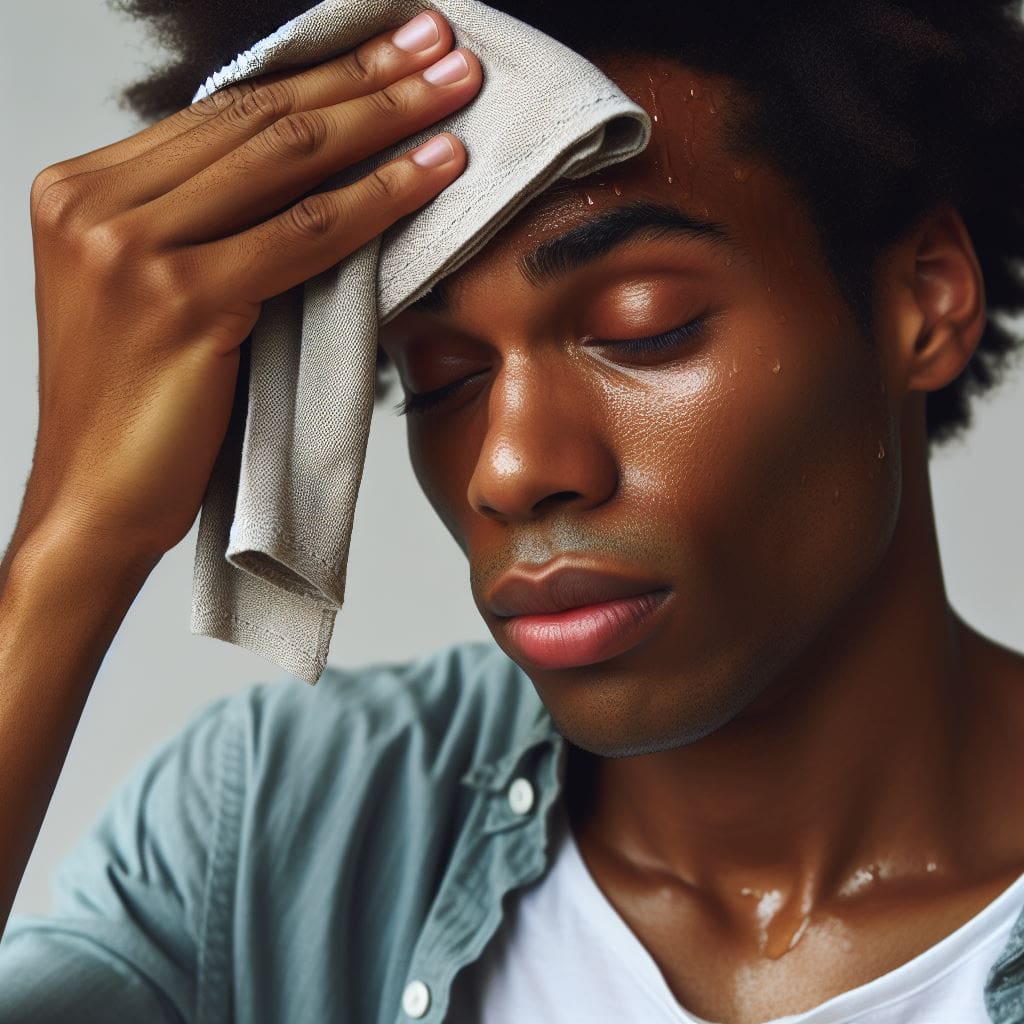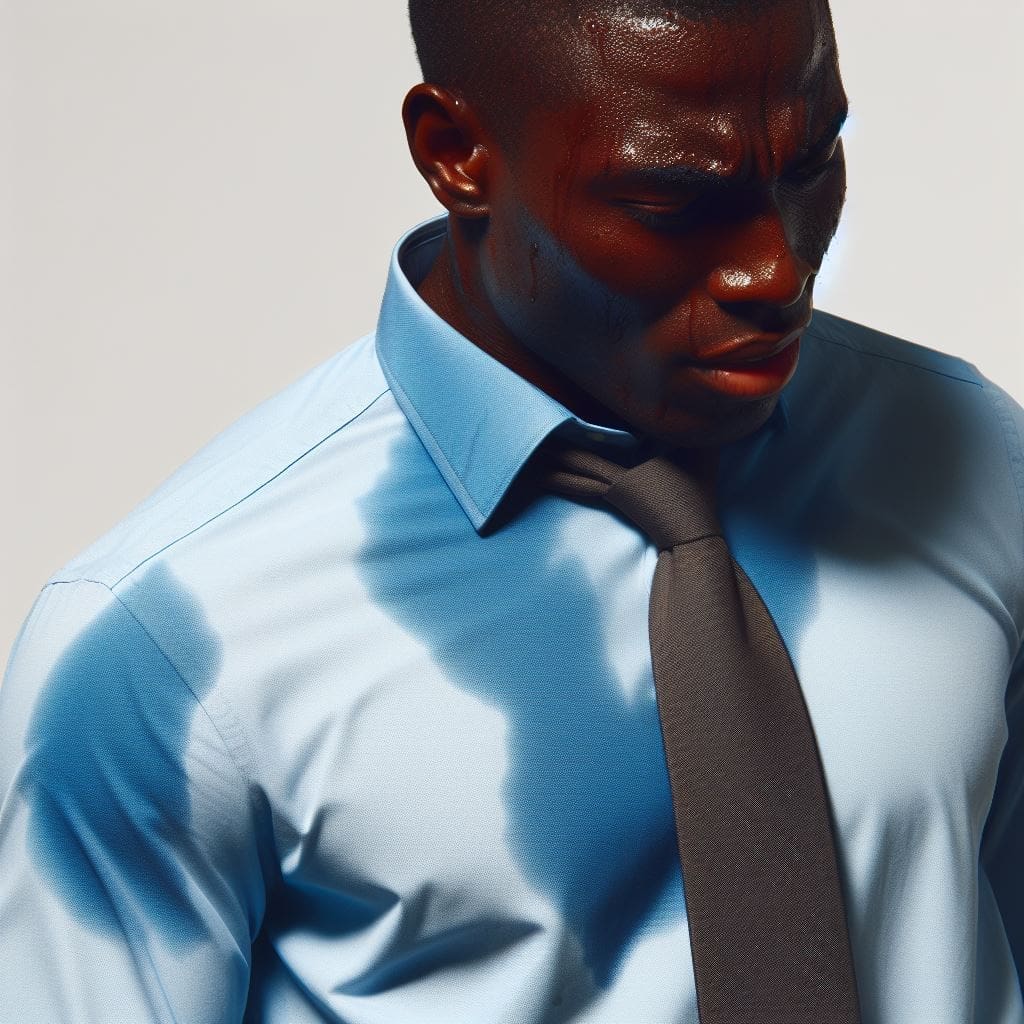Do you ever feel like your body has a built-in sprinkler system? If excessive sweating disrupts your daily life, you might be dealing with hyperhidrosis.
This can cause you to sweat more than you need to, but don’t worry, it’s a common condition that causes uncontrollable sweating beyond what’s necessary for temperature regulation, and there are treatments available to help manage it

This guide will help you understand the condition called hyperhidrosis, which causes excessive sweating.
We’ll explain what causes it, how to recognize its symptoms, and give you some practical tips to manage it effectively. By following our advice, you can regain your confidence and keep sweat under control.
Now, let’s get to knowing more about this condition.
What is Hyperhidrosis?
Hyperhidrosis, also known as excessive sweating or sudorrhea, is a condition in which your body sweats more than required, sometimes without any apparent reason.
It can affect specific areas like the palms, underarms, feet, or the entire body (generalized hyperhidrosis).
While sweating is a natural and healthy bodily function, hyperhidrosis disrupts daily activities and can lead to social anxiety and embarrassment, but it’s not uncommon.
Hyperhidrosis affects an estimated 1% of the population, and various treatment options can significantly improve your quality of life.

Types of Hyperhidrosis
Hyperhidrosis can be categorized into two main types:
- Primary Hyperhidrosis: This is the most common form, affecting around 85% of cases. The cause is unknown, but it’s believed to be related to a malfunction of the nervous system that controls sweat glands. Primary hyperhidrosis usually starts in childhood or adolescence and tends to be hereditary.
- Secondary Hyperhidrosis: This type arises due to an underlying medical condition, medication side effects, or hormonal changes. Examples of underlying conditions include hyperthyroidism, diabetes, heart disease, and anxiety disorders. Secondary hyperhidrosis typically develops later in life and often affects a wider area of the body.
Symptoms of Hyperhidrosis
The primary symptom of hyperhidrosis is excessive sweating that occurs frequently, even in cool temperatures or at rest.
Here are some specific signs to watch for:
- Visible sweat on the palms, soles, or underarms, even in cool environments
- Frequent soaking of clothes
- Difficulty gripping objects due to sweaty palms
- Slipping hands or feet
- Skin irritation or discomfort in affected areas
- Social anxiety or embarrassment due to sweating
Causes of Hyperhidrosis
As mentioned earlier, the exact cause of primary hyperhidrosis remains unknown.
However, it’s thought to be linked to a problem with the sympathetic nervous system, the part of the nervous system responsible for the body’s fight-or-flight response.
In hyperhidrosis, the nervous system inappropriately triggers excessive sweat production.
Secondary hyperhidrosis, on the other hand, has various potential causes, including:
- https://lnh.wzo.mybluehost.me/understanding-and-preventing-heart-disease/Medical conditions: Hyperthyroidism, diabetes, heart disease, Parkinson’s disease, and some neurological disorders.
- Medications: Certain antidepressants, painkillers, and hormonal medications can trigger sweating as a side effect.
- Hormonal changes: Menopause, pregnancy, and certain hormonal imbalances can lead to increased sweating.
- Infections: Some infections, like tuberculosis, can cause night sweats.
Diagnosing Hyperhidrosis
If you suspect you might have hyperhidrosis, it’s crucial to consult a doctor for proper diagnosis. While there’s no single definitive test, your doctor will likely:
- Discuss your medical history and symptoms in detail.
- Perform a physical examination to assess the affected areas and rule out any underlying medical conditions.
- Conduct a starch-iodine test, which involves applying iodine to the sweaty area and sprinkling it with starch. Sweating turns the starch dark blue, indicating the presence of hyperhidrosis.
- In some cases, a thermoregulatory sweat test might be used, which measures sweat production by monitoring skin conductivity.
Management Strategies for Excessive sweating
There’s no cure for hyperhidrosis, but several effective management strategies can significantly reduce sweating and improve your quality of life. Here’s an overview of the different approaches:
- Healthy Habits: Certain lifestyle modifications can help manage hyperhidrosis:
- Stress Management: Since stress can worsen sweating, relaxation techniques like deep breathing, meditation, and yoga can be beneficial.
- Dietary Changes: Limiting caffeine, alcohol, and spicy foods can help regulate sweating, as these substances can trigger the body’s heat response.
- Clothing Choices: Opt for natural, breathable fabrics like cotton or linen that allow for better moisture absorption.
- Footwear: Choose absorbent socks and well-ventilated shoes to manage sweaty feet.
Over-the-counter Antiperspirants
Over-the-counter (OTC) antiperspirants are often the first line of defense against hyperhidrosis.
These products contain aluminum chloride, which works by forming a temporary plug within sweat gland ducts, reducing the amount of sweat reaching the skin’s surface.
Here’s what to know about using OTC antiperspirants for hyperhidrosis:
- Strength Matters: Regular drugstore antiperspirants might not be strong enough for hyperhidrosis. Look for clinical-strength formulas containing a higher concentration of aluminum chloride (usually around 15-20%).
- Application Tips: Apply the antiperspirant at night to clean, dry skin before bedtime. This allows the aluminum chloride more time to work effectively.
- Potential Irritation: Be aware that some people experience irritation from OTC antiperspirants. Start with a lower concentration and gradually increase it if tolerated. You can also apply a moisturizer after the antiperspirant dries to minimize irritation.
- Finding the Right Product: Experiment with different brands and application methods to see what works best for you. Some antiperspirants come in roll-on, stick, or spray forms.
Prescription Antiperspirants
If OTC options aren’t strong enough, your doctor might prescribe a higher-strength aluminum chloride solution (up to 25%).
These prescription antiperspirants may require less frequent application (once or twice a week) compared to OTC products.
Iontophoresis: A Drug-Free Option
Iontophoresis is a non-invasive treatment that uses low-level electrical currents to temporarily block sweat glands. During treatment, you immerse the affected area (hands or feet) in shallow water trays with electrical currents passing through the water.
Iontophoresis can be quite effective for palmar and plantar hyperhidrosis (sweaty palms and feet). However, it requires regular treatments (usually several times a week initially, then gradually less frequently for maintenance) and might not be suitable for everyone due to potential tingling sensations during treatment.
Botox Injections: Targeted Sweat Reduction
Botulinum toxin (Botox) injections are a popular treatment for hyperhidrosis, particularly underarm sweating. Botox works by blocking the nerve signals that stimulate sweat glands.
The effects typically last for 4-6 months, requiring repeat injections for continued control.
Botox injections are a safe and effective option for many people with hyperhidrosis. However, they can be expensive and are not covered by all insurance plans.
Additionally, some people might experience temporary side effects like weakness or bruising at the injection site.
MiraDry: Microwave Technology for Underarm Sweat
MiraDry is a relatively new treatment that uses microwave energy to target and destroy sweat glands in the underarms.
This minimally invasive procedure offers a long-lasting solution for underarm hyperhidrosis, with results often lasting for several years.
While MiraDry is a promising option, it’s important to consider its cost and potential side effects like temporary numbness or tingling in the underarms.
Surgery: A Last Resort
Surgery is typically considered a last resort for severe cases of hyperhidrosis that haven’t responded to other treatments. There are two main surgical options:
- Endoscopic thoracic sympathectomy (ETS): This procedure disrupts the nerves that control sweating in the hands, underarms, and sometimes the face. However, ETS is a major surgery with potential side effects like compensatory sweating (increased sweating in other areas of the body).
- Sweat gland removal: This surgery involves surgically removing sweat glands from the affected area, usually the underarms. While effective, it can leave scars and carries the risk of damaging nerves or blood vessels.
Conclusion: Finding Your Sweat Solution
Hyperhidrosis might sound daunting, but with various effective management strategies available, you can significantly reduce excessive sweating and regain control of your daily life.
Talk to your doctor to discuss the best approach for your specific needs and explore the options that can help you feel more confident and comfortable.
Remember, managing hyperhidrosis is a journey, not a destination. It might take some trial and error to find the right combination of treatments that work best for you.
Don’t hesitate to discuss your concerns and progress with your doctor to ensure you receive the most effective treatment plan.



